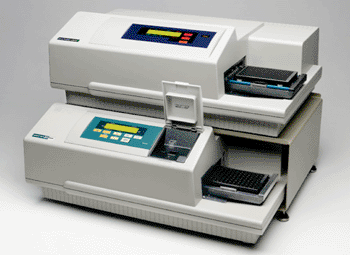Nanotechnology Urine Test Could Detect Blood Clots
By LabMedica International staff writers
Posted on 29 Oct 2013
A simple urine test that uses nanoparticles to detect thrombin, a major blood-clotting element has been developed. Posted on 29 Oct 2013
Nanoparticles have been engineered that survey the host vasculature for thrombi and in response to thrombin activity, release reporters into the urine as an integrated measure of the aggregate burden of systemic clots.

Image: SpectaMax Plus Absorbance Microplate Readers (Photo courtesy of Molecular Devices).
Chemical engineers at the Massachusetts Institute of Technology (MIT; Cambridge, MA, USA) developed a system the uses iron oxide nanoparticles that the US Food and Drug Administration (FDA; Silver Springs, MD, USA) has approved for use in humans. These nanoparticles are coated with short proteins known as peptides that are specifically made to interact with thrombin. The nanoparticles were injects into mice, move through the body and when they come across thrombin, the thrombin splits the peptides at a specific location, which releases particles that leak out into the urine.
These protein fragments in the urine can be identified after treating the sample with antibodies that are specific to peptide tags in the fragments. The number of these tags found in the urine is proportional to the level of blood clotting in the lungs of the mice. The construction of synthetic biomarkers for thrombosis involves modifying the surface of iron oxide nanoworms (NW), a nanoparticle formulation with substrate-reporter tandem peptides that are cleavable by thrombin and detectable by enzyme-linked immunosorbent assay (ELISA). The team built a system of ligand-encoded reporters that would allow quantification of protease activity in a 96-well format by ELISA, the primary detection platform for many clinical tests. The absorbance of the wells was determined at 450 nm by SpectraMax Plus microplate analysis (Molecular Devices; Sunnyvale, CA, USA).
The authors concluded that their work further broadens the repertoire of nanomedicines that could be used for noninvasive monitoring of disease, and anticipate that generalization to additional clinical settings in which dysregulated thrombin activity is prominent. Sangeeta N.Bhatia, MD, PhD, a professor at MIT and the senior author said, “Some patients are at more risk for clotting, but existing blood tests are not consistently able to detect the formation of new clots. So we took the test we had developed before, which is an injectable nanoparticle, and made it a thrombin sensor.” The study was published on September 9, 2013, in the journal ACS Nano.
Related Links:
Massachusetts Institute of Technology
US Food and Drug Administration
Molecular Devices













